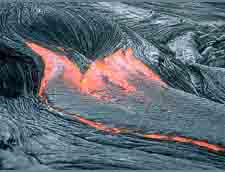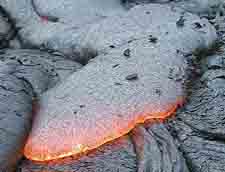Sign up for Lesson Plans, discounts & more!
Igneous Rocks
Born of Fire
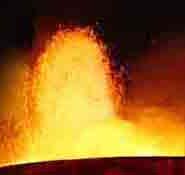
Igneous rocks get their name from the latin word for fire “igneus”. The name is appropriate because these rocks are born of fire. Beneath the thin rocky crust of the earth is the inferno of the mantle! The mantle is the origin of all of this type of rocks.
The Mantle Source of All Igneous Rocks
The Mantle
Under the crust is the fiery hot mantle. Saying that the mantle is fiery
hot does it injustice. The coolest outer part of the mantle is about
1000 degrees Celsius (1800 degrees Fahrenheit). Here the rock is molten
liquid, white hot.
All Magma is made up of a fairly uniform mixture of elements. Some of the major elements present are silica, iron, sodium, potassium, aluminum, magnesium, and gasses including water vapor, oxygen, carbon dioxide, nitrogen, hydrogen and sulfur dioxide. These elements form chemical combinations that crystallize in patterns to form eight basic rock forming minerals. These eight minerals form most rock. They are olivine, pyroxene, amphibole, orthoclase, plagioclase, muscovite, biotite, and quartz.
The Formation of Igneous Rock
Igneous rocks are formed from this molten magma. These rocks form when
the magma cools and crystallizes. This can happen above ground as with
volcanoes it is then called extrusive.
There are many kinds of volcanoes around the world. The materials that come from a volcano are different as well. We tend to lump them all under the term lava but rocks ranging from the very dense basalt to the very light pumice are just a part of what can come from a volcano. There is also ash, volcanic glass or obsidian, and the gem stone peridot to name a few.
The molten magma can also crystalize below the surface. When the molten rock rises in the crust but cools before it reaches the surface it is plutonic igneous rock and is categorized as intrusive. Pegmatite is an example of an intrusive rock.
How Cool
When the magma reaches the surface it cools quickly, a matter of days or weeks.
When the magma forms pockets underground it cools much more slowly. This could take thousands or even millions of years.
The rate at which the magma cools determines the kind of rocks that are formed. Faster cooling surface lava creates rock that is fine grained or aphanitic. The rapid cooling doesn’t allow large crystals to form. I addition most of the gasses are driven off into the atmosphere.
The slower cooling that takes place underground allows larger crystal formation. Granite is an example of this type of rock formation.
Other igneous rocks are pumice, scoria, granite, pegmatite, gabbro, basalt, ryolite, dacite, andesite and obsidian.
All rocks begin as igneous rocks. Before rocks can be transformed by
sedimentation and weathering or metamorphosed by the heat and pressure
of plate tectonics they must first be cooled from the intense heat of
the mantle. Whether they are formed from plutonic rocks deep within the
crust of the earth or extruded onto the surface of the earth by
volcanoes all rocks have a fiery beginning as igneous rocks.
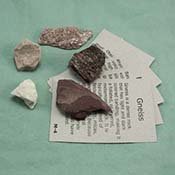 |
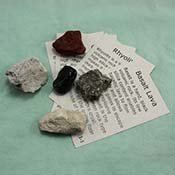 |
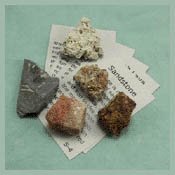 |

INTERESTED IN MORE? IF SO, YOU MAY WANT TO CHECK OUT OUR OTHER SITES:
fossilicious.com - Our online fossil and mineral rock shop.
fossils-facts-and-finds.com - An educational site about fossils.
